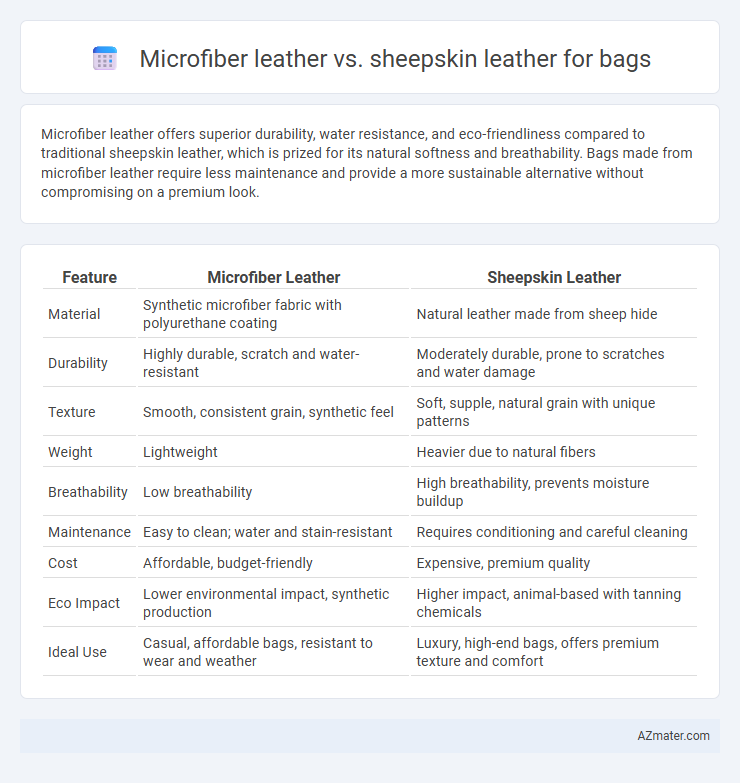Microfiber leather offers superior durability, water resistance, and eco-friendliness compared to traditional sheepskin leather, which is prized for its natural softness and breathability. Bags made from microfiber leather require less maintenance and provide a more sustainable alternative without compromising on a premium look.
Table of Comparison
| Feature | Microfiber Leather | Sheepskin Leather |
|---|---|---|
| Material | Synthetic microfiber fabric with polyurethane coating | Natural leather made from sheep hide |
| Durability | Highly durable, scratch and water-resistant | Moderately durable, prone to scratches and water damage |
| Texture | Smooth, consistent grain, synthetic feel | Soft, supple, natural grain with unique patterns |
| Weight | Lightweight | Heavier due to natural fibers |
| Breathability | Low breathability | High breathability, prevents moisture buildup |
| Maintenance | Easy to clean; water and stain-resistant | Requires conditioning and careful cleaning |
| Cost | Affordable, budget-friendly | Expensive, premium quality |
| Eco Impact | Lower environmental impact, synthetic production | Higher impact, animal-based with tanning chemicals |
| Ideal Use | Casual, affordable bags, resistant to wear and weather | Luxury, high-end bags, offers premium texture and comfort |
Introduction: Microfiber Leather vs Sheepskin Leather
Microfiber leather offers exceptional durability, water resistance, and eco-friendliness, making it a popular choice for modern bags. Sheepskin leather provides a luxurious, soft texture with natural breathability and a unique, elegant appearance valued in premium bag craftsmanship. Both materials cater to different preferences, with microfiber leather excelling in practicality and sheepskin leather emphasizing comfort and aesthetics.
Material Composition and Manufacturing Process
Microfiber leather is composed of ultra-fine synthetic fibers combined with a polyurethane coating, engineered to mimic the texture and durability of natural leather while offering water resistance and easy maintenance. Sheepskin leather originates from the tanned hide of sheep, characterized by its soft, supple texture and natural grain, developed through traditional tanning and finishing techniques that enhance breathability and flexibility. The manufacturing process of microfiber leather involves advanced chemical and mechanical treatments to create a uniform synthetic surface, whereas sheepskin leather undergoes a multi-step natural tanning process preserving its organic structure and unique markings.
Durability and Longevity Comparison
Microfiber leather offers superior durability compared to sheepskin leather, as its synthetic fibers resist scratches, stains, and moisture more effectively, resulting in long-lasting wear. Sheepskin leather, while softer and more luxurious, is prone to scuffs and requires careful maintenance to prevent cracking or fading over time. For bag longevity, microfiber leather's resilience makes it a better choice for frequent use and exposure to varying environmental conditions.
Appearance and Texture Differences
Microfiber leather offers a consistent, smooth surface with a sleek, uniform texture that mimics genuine leather but remains more resistant to stains and scratches. Sheepskin leather displays a natural, supple texture with unique grain patterns, providing a softer feel and a more luxurious, organic appearance. The choice between microfiber and sheepskin leather for bags hinges on desired durability and tactile experience, with microfiber leaning toward modern, polished looks and sheepskin emphasizing authentic richness and softness.
Weight and Flexibility for Bags
Microfiber leather is significantly lighter than sheepskin leather, making it ideal for bags that require easy portability and less strain. Sheepskin leather offers superior flexibility and softness, providing a more comfortable feel and better moldability for bag shapes. The choice between these materials depends on whether weight reduction or luxurious flexibility is the priority in bag design.
Water Resistance and Maintenance
Microfiber leather offers superior water resistance compared to sheepskin leather, making it highly suitable for bags exposed to wet conditions. Its synthetic composition enables easy cleaning and minimal maintenance, resisting stains and moisture effectively. Sheepskin leather, while luxurious, requires regular conditioning and careful protection from water to avoid damage and maintain its natural softness.
Environmental Impact and Sustainability
Microfiber leather offers a more sustainable alternative to sheepskin leather by reducing the environmental impact associated with animal farming, such as methane emissions and land use. Its production consumes less water and generates fewer greenhouse gases, aligning with eco-friendly manufacturing practices. Sheepskin leather, while durable, relies on animal agriculture, which contributes to deforestation and biodiversity loss, making microfiber leather a greener choice for environmentally conscious consumers.
Cost Analysis: Microfiber vs Sheepskin Leather
Microfiber leather offers a significantly lower cost compared to sheepskin leather, making it a budget-friendly option for bags without sacrificing durability. Sheepskin leather commands a higher price due to its natural texture, breathability, and premium feel, which appeals to luxury market segments. When evaluating cost-effectiveness, microfiber leather provides better value for mass-produced or affordable bags, while sheepskin leather suits high-end designs with greater investment.
User Experience and Performance Reviews
Microfiber leather offers superior durability and water resistance compared to sheepskin leather, making it ideal for daily-use bags exposed to varying weather conditions. Users report that microfiber leather maintains its appearance longer, resisting scratches and stains better, while sheepskin leather provides a luxurious, soft touch and breathability but requires more careful maintenance. Performance reviews highlight microfiber leather's ease of cleaning and cost-effectiveness, whereas sheepskin leather is praised for its comfort and premium aesthetic despite higher susceptibility to wear and moisture damage.
Conclusion: Which Leather is Better for Bags?
Microfiber leather offers superior durability, water resistance, and eco-friendly qualities, making it ideal for everyday, high-use bags that require low maintenance. Sheepskin leather provides a luxurious, soft texture and natural breathability but demands careful care and is less resistant to wear and moisture. For practical, long-lasting bags, microfiber leather is generally the better choice, while sheepskin leather suits premium, fashion-focused designs where comfort and style are prioritized.

Infographic: Microfiber leather vs Sheepskin leather for Bag
 azmater.com
azmater.com